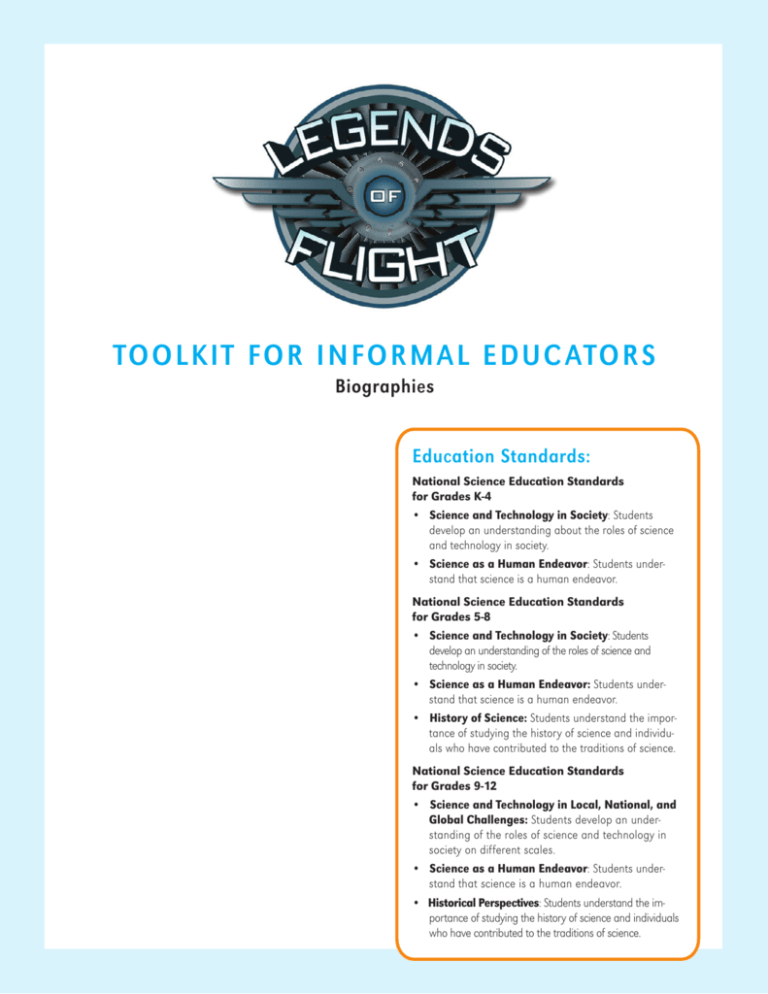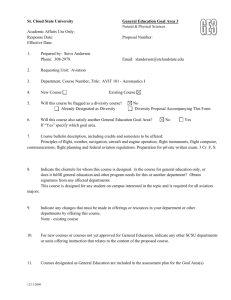- Legends of Flight
advertisement

TO O LK I T F OR I N F O R M AL E DUC ATO R S Biographies Education Standards: National Science Education Standards for Grades K-4 • Science and Technology in Society: Students develop an understanding about the roles of science and technology in society. • Science as a Human Endeavor: Students understand that science is a human endeavor. National Science Education Standards for Grades 5-8 • Science and Technology in Society: Students develop an understanding of the roles of science and technology in society. • Science as a Human Endeavor: Students understand that science is a human endeavor. • History of Science: Students understand the importance of studying the history of science and individuals who have contributed to the traditions of science. National Science Education Standards for Grades 9-12 • Science and Technology in Local, National, and Global Challenges: Students develop an understanding of the roles of science and technology in society on different scales. • Science as a Human Endeavor: Students understand that science is a human endeavor. • Historical Perspectives: Students understand the importance of studying the history of science and individuals who have contributed to the traditions of science. LEGENDS OF FLIGHT BIOGRAPHIES Many people have contributed to advances in the science of flight as well as advancing technological innovations within the aerospace industry. This section features brief biographies of a select number of legends of flight. These biographies can be used in various ways in the museum setting, including: • Feature a legend of the sky on a museum website, within a newsletter, or on visitor handouts. • Create posters to celebrate each legend of the sky. Exhibit these at special events, workshops, or classes. • Docents can use the biographies as the basis for trivia questions when interacting with museum visitors. Charles Yeager Mike Carriker Nancy Bird-Walton Born in Myra, West Virginia, U.S.A. February 13, 1923 On October 4, 1947 at Edwards Air Force Base, Yeager became the first person to pilot an aircraft (the Bell X-1) faster than the speed of sound. On December 12, 1953, Yeager piloted a later model of this rocket-powered research aircraft, becoming the first person to exceed Mach 2, which is twice the speed of sound. In addition to his many decorations for valor, Yeager has been honored with the award of the Collier, Mackay, and Harmon International Trophies for his contributions to the advance of aeroscience. Born in Montgomery, Alabama, U.S.A. Date of birth not public Born in Sydney, New South Wales, Australia October 16, 1915 - As a test pilot for the United Stated Navy and The Boeing Company, Carriker has completed over 7,500 flight hours—and many of those were spent in the cockpits of new airplanes still under development. Carriker has tested many different types of aircraft, including Boeing’s 787, 777, 737, and the Boeing Business Jet. He is licensed to fly historic aircraft, including the 1933 Boeing 247D and the 1940 Boeing 307. During his military career, Carriker piloted F-18s and A7-Es, and made hundreds of aircraft carrier take-offs and landings. Carriker’s contribution to the aeronautical field was honored with the American Institute of Aeronautics and Astronautics Octave Chanate award. Bird-Walton founded the Australian Women Pilots’ Association in 1950 and remained president until 1990. The Association’s motto was “skies unlimited.” Thanks to Bird-Walton’s pioneering air days, women are now working as airline, helicopter, military, and rescue pilots all over the world. Sir Frank Whittle & Hans J. von Ohain Whittle: Born in Coventry, England June 1, 1907 – August 9, 1996 Ohain: Born in Dessau, Germany December 14, 1911 - March 13, 1998 Steve Fossett Born in Jackson, Tennessee, U.S.A. April 22, 1944 – Missing as of September 3, 2007 Fossett was among the world’s greatest adventurers and an avid pilot of hot air balloons, airplanes, and sailboats. In his career, Fossett set 115 new world records or world firsts, including holding current official World Records in five sports. In 2005, Fossett achieved the first solo non-stop around the World fixed-wing airplane flight and in 2006 achieved the record for the longest non-stop flight in aviation history, flying a total of 22,390 n.m. (41,467 km). Fossett was declared missing in September 2007 when his single-engine airplane disappeared after taking off in Nevada. He was declared dead in February 2008. These two men are both credited for inventing the jet engine for aircraft. Whittle, from England, was the first to register a patent for his jet turbine design in 1930. Von Ohain, from Germany, was granted his patent in 1936. Neither man knew of each other’s work. Ohain worked with a German aircraft manufacturer to design the Heinkel He-178, the world’s first jet turbine powered aircraft. The plane first flew in 1939. Two years later, the Pioneer airplane took its first flight powered by Whittle’s W1 engine. 2 Jacqueline Cochran Bessie Coleman Born in Muscogee, Florida, U.S.A. May 11, 1906 – August 7, 1980 Born in Atlanta, Texas, U.S.A. January 26, 1892 - April 30, 1926 Cochran formed the famed Women Airforce Service Pilots (WASP) during World War II. Among her last flight activities was the establishment in 1964 of a record of 1,429 mph (2,299.69 km/hr) in the F-104 Starfighter. Her legendary piloting skills earned her numerous aviation awards from many different countries. Coleman was the first African-American (including both men and women) to earn a pilot’s license in the United States. Named “the world’s greatest woman flyer,” Coleman first performed in an air show on September 3, 1922 at Curtiss Field near New York City. Her dream of a flying school for African Americans became a reality when the Bessie Coleman Aero Club was opened in Los Angeles, California in 1929. Olive Ann Beech Earle L. Ovington Born in Waverly, Kansas, U.S.A. September 25, 1903 – July 6, 1993 Birthplace unknown ? – 1936 Beech is known as the First Lady of Aviation. In 1932, Beech and her husband Walter H. Beech founded the Beech Aircraft Corporation in Wichita, Kansas, which in fifty years grew to a company with sales in excess of $900 million. In 1936, Beech decided to enter one of the company’s planes, the Staggerwing, in the National Air Races, a race from one coast of United States to the other. Beech decided that a female pilot and navigator would be an interesting marketing ploy. Pilot Louise Thaden and navigator Blanche Noyes won the race. Beech was inducted into the National Hall of Aviation in 1981. Ovington was the first air mail carrier in the U.S. He flew the first experimental air mail route for one week in September 1911 on a 6 mi. (9.7 km) route from Long Island to Mineola in New York. Prior to becoming a pilot, Ovington worked as an assistant to Thomas Edison. Based on the success of Ovington’s mail route, the U.S. Air Mail Service was established on May 15, 1918, with a route between New York City and Washington D.C. The U.S. Air Mail Service soon expanded to supply air service across the country. The first international mail route was established on March 3, 1919 from Vancouver, British Columbia to Seattle, Washington. The Boeing Company founder, Bill Boeing, along with co-pilot Eddie Hubbard, flew that historical route. Charles Lindbergh Born in Detroit, Michigan, U.S.A. February 4, 1902 – August 26, 1974 Jacob Christian Ellehammer Born in Bakkebolle, Denmark June 14, 1871 – May 20, 1946 On September 12, 1906, Ellehammer became the first European to fly an airplane. He was unaware of the Wright brothers’ first flight in December of 1903. Ellehammer’s flight of 1,381.23 ft. (421 m) at an altitude of 19.68 in. (50 cm) took place on the tiny island of Lindholm. Later, Ellehammer turned his attention toward the challenge of vertical flight. In 1912, he succeeded in making a helicopter rise from the ground. On May 21, 1927, Charles Lindbergh became the first man to make a solo crossing of the Atlantic Ocean in an airplane. He designed and built his airplane, The Spirit of St. Louis. The plane touched down at Le Bourget aerodrome outside of Paris, France, after the historic 33 hour and 29 minute flight. 3 Orville, Wilbur & Katherine Wright Hugo Junkers Wilbur: Born in Dayton, Ohio, U.S.A. April 16, 1867 – May 30, 1912 Orville: Born in Millville, Indiana, U.S.A. August 19, 1871 – January 30, 1948 Katherine: Born in Dayton, Ohio, U.S.A. August 19, 1874 – March 3, 1929 Born in Rheydt, Germany February 3, 1859 – February 3, 1935 A man of great ability and vision, Junkers advanced the science of flight and passenger transport. He is honored for his contributions to aviation, including his invention of the “sheetmetal donkey,” the first realistic design for an all-metal airplane. He was credited with inventions in heating systems and innovative engine designs for aircraft. Daniel Bernoulli Born in Groningen, the Netherlands February 8, 1700 – March 17, 1782 It was on a cold, cloudy day at Kill Devil Hill in Kitty Hawk, North Carolina that the Wright Brothers made history. On December 17, 1903, Orville and Wilbur Wright became the first men in history to make sustained, controlled, powered flight. The Wright Brothers became known as co-inventors of the Wright Flyer and founders of The Wright Company. Katherine assisted her brothers with their experimental flights and later became an active officer in The Wright Company. Daniel Bernoulli was a Swiss mathematician born right around the time Newton was perfecting his laws of motion. Bernoulli thought of air as a liquid and proved that the pressure of a flowing fluid or gas decreases as its velocity increases. Today, we call this concept Bernoulli’s Principle. Bernoulli’s Principle explains how lift is created by an airplane wing. Tsu Wong Born in Beijing, China 1893 -1965 Chinese aviation pioneer Wong was the first aeronautical engineer to work at the Boeing Company (then called the Boeing Airplane Co.). Wong is remembered for designing the 1916 Boeing Model C airplane, which was the first airplane completely designed by the company. After returning to China, Wong later negotiated an important WWII fighter jet licensing deal between a Chinese airplane manufacturer and the U.S. government, which provided a major leg-up for the Chinese aviation industry. Wong was a graduate of the Massachusetts Institute of Technology. After working for Boeing for one year, Wong returned to China where he was active in the Chinese aviation industry, became a professor of aeronautics, and was one of the founders of China Airlines. Credits The Legends of FLight Informal Educator’s Toolkit was developed by Kristen Clapper Bergsman and Matthew Merritt for Pacific Science Center, under the direction of project manager Heather Gibbons. Layout, design, and illustrations by Clayton DeFrate. Editing by Sally Armbrecht. An IMAX® Experience LEGENDS OF FLIGHT Directed by Stephen Low Produced by Stephen Low and Pietro Serapiglia Executive produced by Bob Kresser and Jan Baird In Association with the Smithsonian National Air and Space Museum 4








